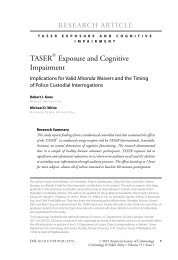1qaSADJ
1qaSADJ
1qaSADJ
Create successful ePaper yourself
Turn your PDF publications into a flip-book with our unique Google optimized e-Paper software.
Special Focus:<br />
Writing Persuasively<br />
Jonathan Edwards: To Speak Rhetorically of Ultimate Things<br />
Jonathan Edwards was a man of paradox: an Enlightenment thinker with reactionary<br />
values, a minister who wanted to turn back the clock to the ideology of the first<br />
generation of Puritans, those who stressed, above all, a commitment to the spiritual<br />
rather than to the material. Some have called Edwards “our country’s first systematic<br />
philosopher.” 1 A product of the Enlightenment, he practiced inductive thinking.<br />
As a Puritan, his thinking was rooted in theology and embodied in memoirs<br />
and sermons, the most famous being “Sinners in the Hands of an Angry God”<br />
(www.jonathanedwards.com/sermons/Warnings/sinners.htm).<br />
Unless students have attended a revival meeting, they probably have no context for the<br />
type of sermon that Edwards was preaching in July of 1741, over a hundred years after the<br />
arrival of the Arabella in Boston. As a first step, before they have even read the sermon, ask<br />
students to discuss the title. What seems to be Edwards’s assumption about the members of<br />
his congregation, perhaps indeed of himself? And what seems to be his assumption about<br />
the nature of God? Have students read the epigraph from Deuteronomy, “Their foot shall<br />
slide in due time.” What associations do they make with these words? What familiar phrases<br />
or proverbs speak of “sliding,” and in what ways—metaphorical and moral—can one slide?<br />
Students now have a better context for reading the sermon itself.<br />
Begin with a look at its structure. Encourage students to note how Edwards constructs his<br />
argument, moving from an explication of the verse from Deuteronomy to an application<br />
of it for his contemporaries. The application section is, in fact, the one often excerpted<br />
from this sermon: the section containing the famous image of the spider—a human<br />
being—suspended by the hand of God over the flames of Hell. Once students have read<br />
the sermon, they can work through the well-known exercise, SOAPS, identifying the text’s<br />
Subject, Occasion, Audience, Purpose, and Speaker—specifically, the speaker’s role or<br />
persona. These steps should, of course, be augmented with follow-up questions that lead<br />
students to explore additional layers of the text.<br />
Edwards here is preaching a particular type of sermon—a jeremiad. The term is derived<br />
from the prophet Jeremiah and indicates a type of sermon or speech in which the speaker<br />
not only rebukes the audience but also challenges them by reminding them of the higher<br />
standards to which they should aspire. In Edwards’s case, those standards were embodied<br />
1<br />
Sculley, Bradley et al., eds., The American Tradition in Literature, 4th ed. (New York: Grosset and Dunlap, Inc.,<br />
1974), 89.<br />
AP® English Language and Composition: 2006–2007 Workshop Materials 33



